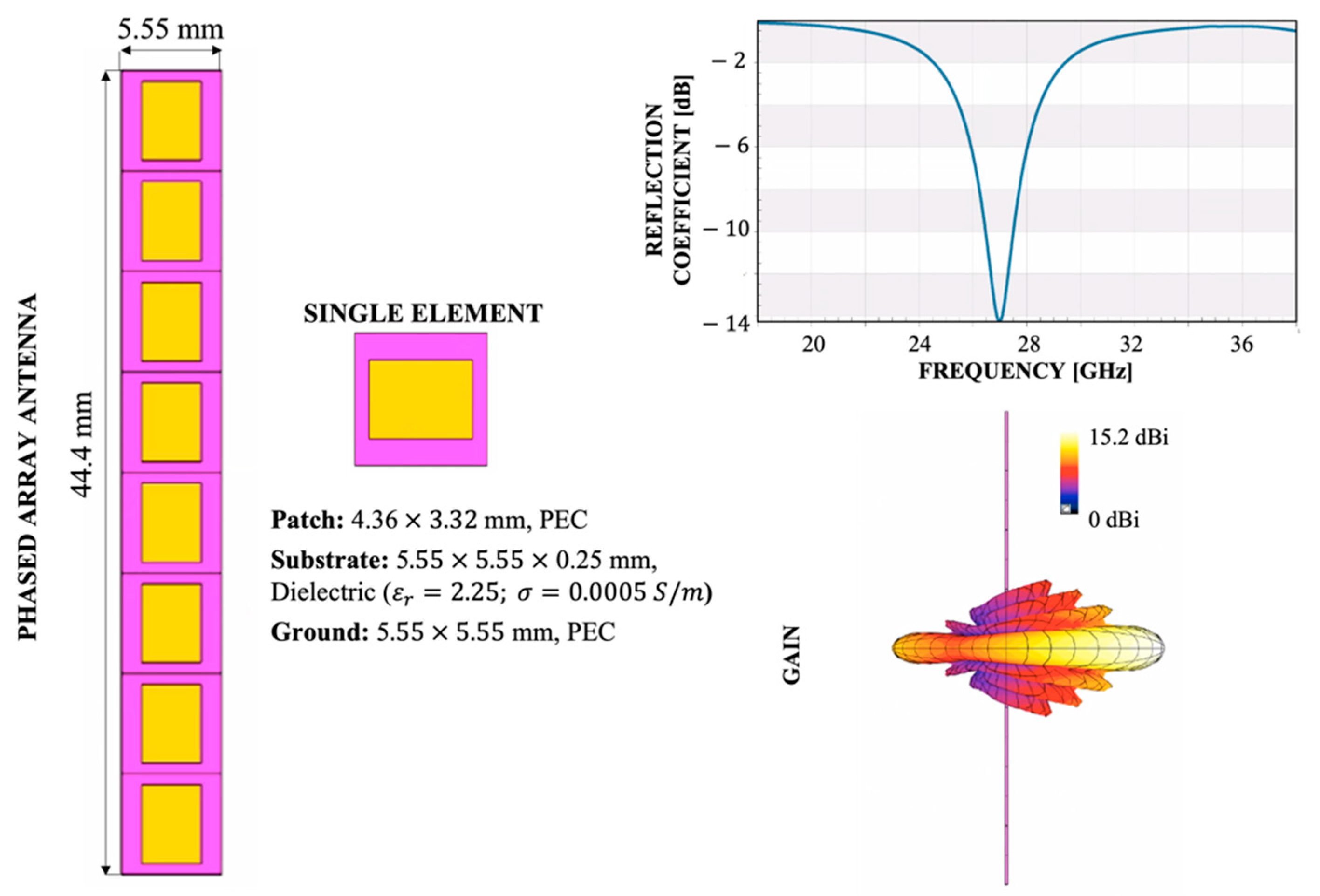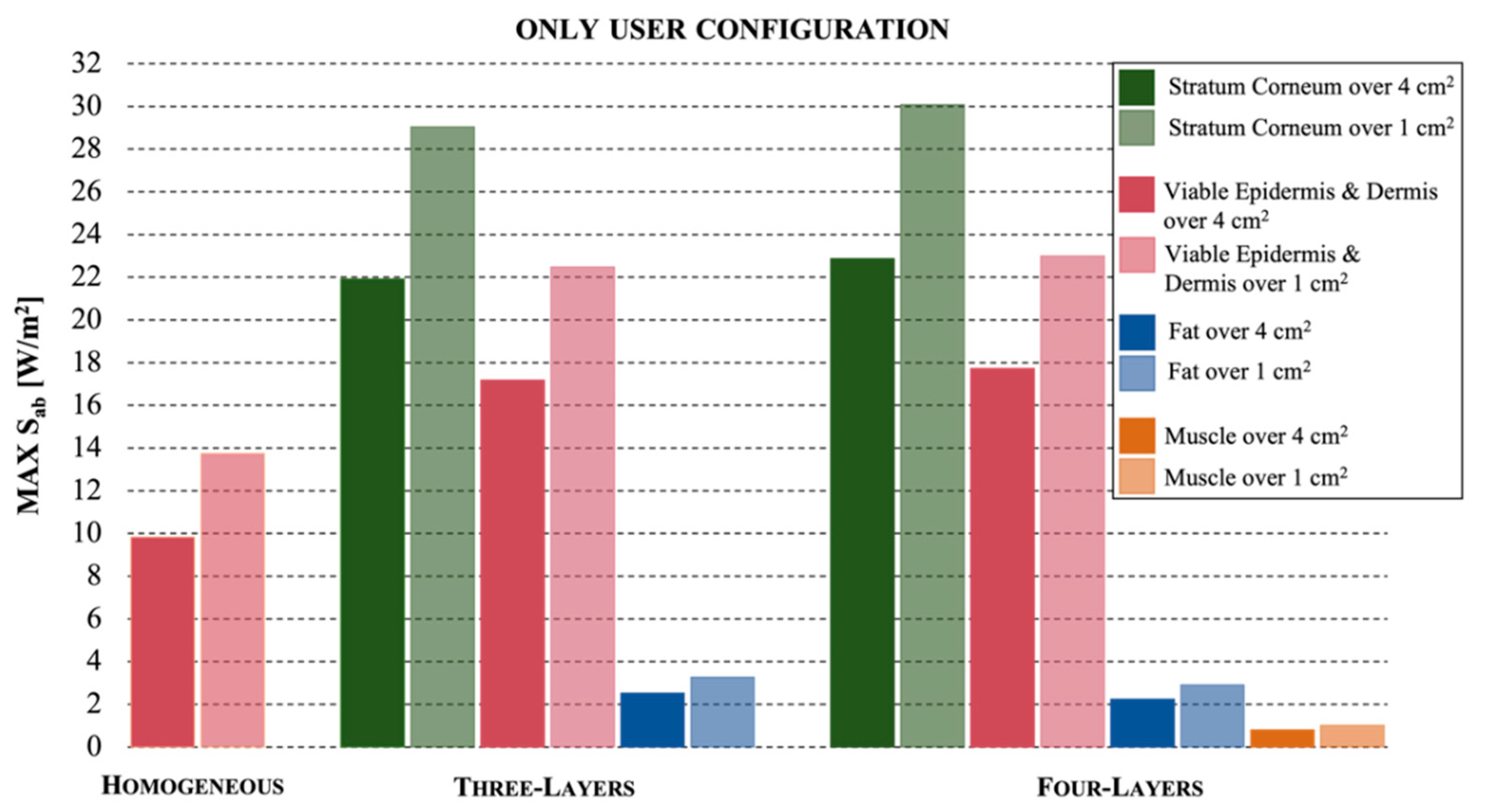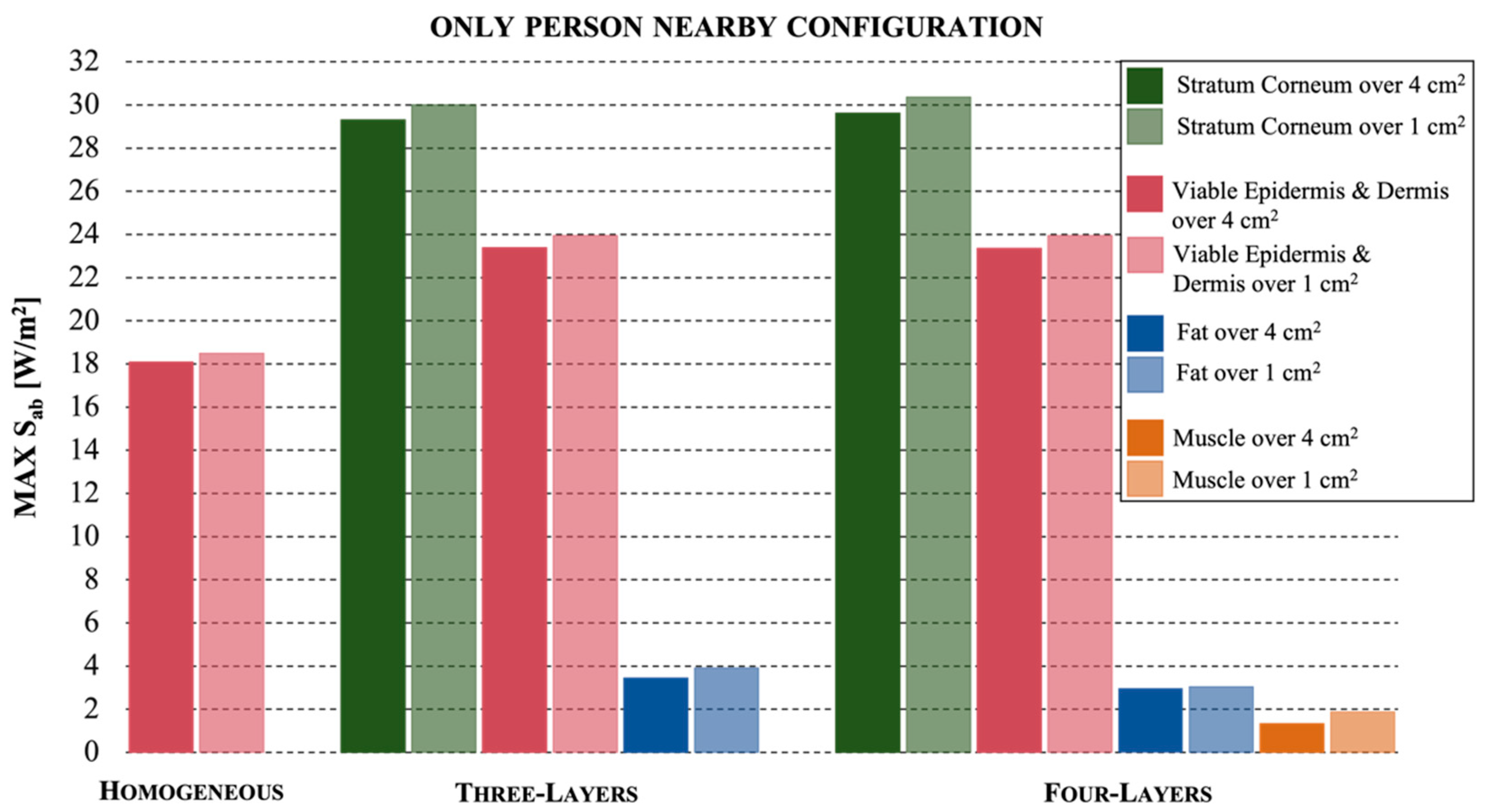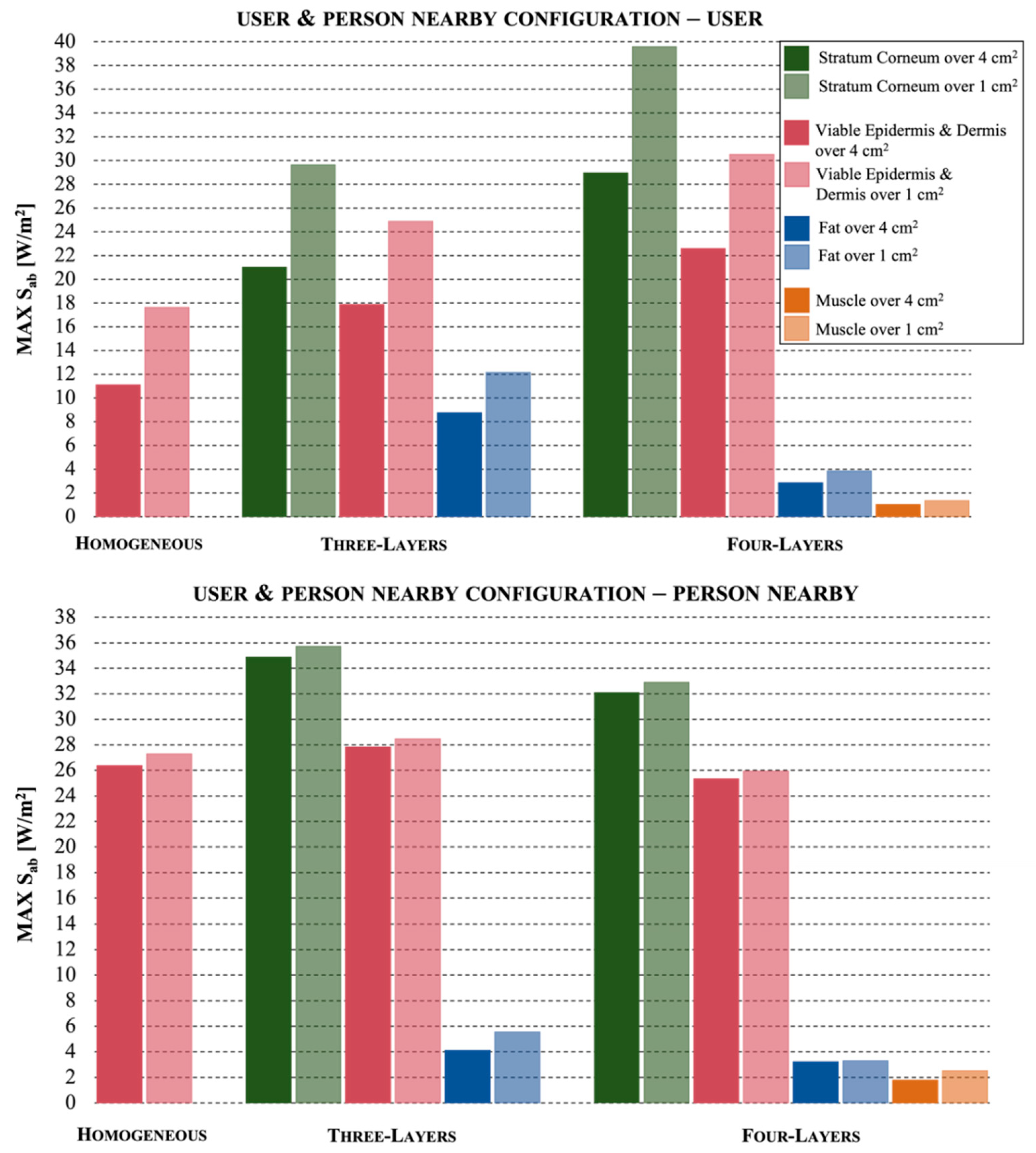Assessment of Human Exposure Levels Due to Mobile Phone Antennas in 5G Networks
Abstract
:1. Introduction
2. Materials and Methods
2.1. Antenna Model
2.2. Anatomical Model of the Skin
2.3. Exposure Assessment
3. Results
4. Discussion
5. Conclusions
Author Contributions
Funding
Institutional Review Board Statement
Informed Consent Statement
Data Availability Statement
Acknowledgments
Conflicts of Interest
References
- Ericsson. Ericsson Mobility Report 5G on the Road to Mass Market. 2021. Available online: https://www.ericsson.com/49f7c7/assets/local/mobility-report/documents/2021/june-2021-ericsson-mobility-report.pdf (accessed on 21 December 2021).
- Andrews, J.G.; Buzzi, S.; Choi, W.; Hanly, S.V.; Lozano, A.; Soong, A.C.; Zhang, J.C. What will 5G be? IEEE J. Sel. Areas Commun. 2014, 32, 1065–1082. [Google Scholar] [CrossRef]
- The 3rd Generation Partnership Project: 3GPP TR 38.802 V14.2.0 (2017-09): Technical Specification Group Radio Access Network; Study on New Radio Access Technology Physical Layer Aspects. Available online: https://panel.castle.cloud/view_spec/38802-e20/pdf/ (accessed on 21 December 2021).
- European 5G Observatory. Available online: https://5gobservatory.eu/national-5g-spectrum-assignment/# (accessed on 19 January 2022).
- Recommendations, ITU-T. K-Series, 5G Technology and Human Exposure to RF EMF. Available online: https://www.itu.int/rec/dologin_pub.asp?lang=e&id=T-REC-K.Sup9-201711-S!!PDF-E&type=items (accessed on 21 December 2021).
- Boccardi, F.; Heath, R.W.; Lozano, A.; Marzetta, T.L.; Popovski, P. Five disruptive technology directions for 5G. IEEE Commun. Mag. 2014, 52, 74–80. [Google Scholar] [CrossRef] [Green Version]
- Massive MIMO for 5G. Available online: https://futurenetworks.ieee.org/tech-focus/march-2017/massive-mimo-for-5g (accessed on 21 December 2021).
- Larsson, E.G.; Edfors, O.; Tufvesson, F.; Marzetta, T.L. Massive MIMO for next generation wireless systems. IEEE Commun. Mag. 2014, 52, 186–195. [Google Scholar] [CrossRef] [Green Version]
- Chin, W.H.; Fan, Z.; Haines, R. Emerging technologies and research challenges for 5G wireless networks. IEEE Wirel. Commun. 2014, 21, 106–112. [Google Scholar] [CrossRef] [Green Version]
- Razavizadeh, S.M.; Ahn, M.; Lee, I. Three-dimensional beamforming: A new enabling technology for 5G wireless networks. IEEE Signal Processing Mag. 2014, 31, 94–101. [Google Scholar] [CrossRef]
- Thors, B.; Colombi, D.; Ying, Z.; Bolin, T.; Törnevik, C. Exposure to RF EMF from array antennas in 5G mobile communication equipment. IEEE Access 2016, 4, 7469–7478. [Google Scholar] [CrossRef]
- Hong, W.; Baek, K.H.; Lee, Y.; Kim, Y.; Ko, S.T. Study and prototyping of practically large-scale mmWave antenna systems for 5G cellular devices. IEEE Commun. Mag. 2014, 52, 63–69. [Google Scholar] [CrossRef]
- Hong, W. Solving the 5G mobile antenna puzzle: Assessing future directions for the 5G mobile antenna paradigm shift. IEEE Microw. Mag. 2017, 18, 86–102. [Google Scholar] [CrossRef]
- Hong, W.; Baek, K.H.; Ko, S. Millimeter-wave 5G antennas for smartphones: Overview and experimental demonstration. IEEE Trans. Antennas Propag. 2017, 65, 6250–6261. [Google Scholar] [CrossRef]
- Bushberg, J.T.; Chou, C.K.; Foster, K.R.; Kavet, R.; Maxson, D.P.; Tell, R.A.; Ziskin, M.C. IEEE Committee on Man and Radiation—COMAR Technical Information Statement: Health and safety issues concerning exposure of the general public to electromagnetic energy from 5G wireless communications networks. Health Phys. 2020, 119, 236. [Google Scholar] [CrossRef]
- ICNIRP. Guidelines for limiting exposure to Electromagnetic Fields (100 kHz to 300 GHz). Health Phys. 2020, 118, 483–524. [Google Scholar] [CrossRef]
- Ziskin, M.C.; Alekseev, S.I.; Foster, K.R.; Balzano, Q. Tissue models for RF exposure evaluation at frequencies above 6 GHz. Bioelectromagnetics 2018, 39, 173–189. [Google Scholar] [CrossRef]
- Hirata, A.; Kodera, S.; Sasaki, K.; Gomez-Tames, J.; Laakso, I.; Wood, A.; Watanabe, S.; Foster, K.R. Human exposure to radiofrequency energy above 6 GHz: Review of computational dosimetry studies. Phys. Med. Biol. 2021, 66. [Google Scholar] [CrossRef]
- Colombi, D.; Thors, B.; TöRnevik, C.; Balzano, Q. RF energy absorption by biological tissues in close proximity to millimeter-wave 5G wireless equipment. IEEE Access. 2018, 6, 4974–4981. [Google Scholar] [CrossRef]
- Colombi, D.; Thors, B.; Törnevik, C. Implications of EMF exposure limits on output power levels for 5G devices above 6 GHz. IEEE Antennas Wirel. Propag. Lett. 2015, 14, 1247–1249. [Google Scholar] [CrossRef]
- Neufeld, E.; Carrasco, E.; Murbach, M.; Balzano, Q.; Christ, A.; Kuster, N. Theoretical and numerical assessment of maximally allowable power-density averaging area for conservative electromagnetic exposure assessment above 6 GHz. Bioelectromagnetics 2018, 39, 617–630. [Google Scholar] [CrossRef]
- Morimoto, R.; Hirata, A.; Laakso, I.; Ziskin, M.C.; Foster, K.R. Time constants for temperature elevation in human models exposed to dipole antennas and beams in the frequency range from 1 to 30 GHz. Phys. Med. Biol. 2017, 62, 1676. [Google Scholar] [CrossRef]
- Laakso, I.; Morimoto, R.; Heinonen, J.; Jokela, K.; Hirata, A. Human exposure to pulsed fields in the frequency range from 6 to 100 GHz. Phys. Med. Biol. 2017, 62, 6980. [Google Scholar] [CrossRef]
- Morelli, M.S.; Gallucci, S.; Siervo, B.; Hartwig, V. Numerical Analysis of Electromagnetic Field Exposure from 5G Mobile Communications at 28 GHZ in Adults and Children Users for Real-World Exposure Scenarios. Int. J. Environ. Res. Public Health 2021, 18, 1073. [Google Scholar] [CrossRef]
- Christ, A.; Samaras, T.; Neufeld, E.; Kuster, N. RF-induced temperature increase in a stratified model of the skin for plane-wave exposure at 6–100 GHz. Radiat. Prot. Dosim. 2020, 188, 350–360. [Google Scholar] [CrossRef]
- Li, K.; Sasaki, K.; Watanabe, S.; Shirai, H. Relationship between power density and surface temperature elevation for human skin exposure to electromagnetic waves with oblique incidence angle from 6 GHz to 1 THz. Phys. Med. Biol. 2019, 64, 065016. [Google Scholar] [CrossRef]
- Samaras, T.; Kuster, N. Theoretical evaluation of the power transmitted to the body as a function of angle of incidence and polarization at frequencies >6 GHz and its relevance for standardization. Bioelectromagnetics 2019, 40, 136–139. [Google Scholar] [CrossRef]
- Ojaroudiparchin, N.; Shen, M.; Zhang, S.; Pedersen, G.F. A switchable 3-D-coverage-phased array antenna package for 5G mobile terminals. IEEE Antennas Wirel. Propag. Lett. 2016, 15, 1747–1750. [Google Scholar] [CrossRef] [Green Version]
- Bang, J.; Choi, J. A SAR reduced mm-wave beam-steerable array antenna with dual-mode operation for fully metal-covered 5G cellular handsets. IEEE Antennas Wirel. Propag. Lett. 2018, 17, 1118–1122. [Google Scholar] [CrossRef]
- Shikhantsov, S.; Thielens, A.; Vermeeren, G.; Demeester, P.; Martens, L.; Torfs, G.; Joseph, W. Statistical approach for human electromagnetic exposure assessment in future wireless atto-cell networks. Radiat. Prot. Dosim. 2019, 183, 326–331. [Google Scholar] [CrossRef] [Green Version]
- Gabriel, C.; Gabriel, S.; Corthout, Y.E. The dielectric properties of biological tissues: I. Literature survey. Phys. Med. Biol. 1996, 41, 2231. [Google Scholar] [CrossRef] [Green Version]
- Gabriel, S.; Lau, R.W.; Gabriel, C. The dielectric properties of biological tissues: II. Measurements in the frequency range 10 Hz to 20 GHz. Phys. Med. Biol. 1996, 41, 2251–2269. [Google Scholar] [CrossRef] [Green Version]
- Taflove, A.; Hagness, S.C.; Piket-May, M. Computational electromagnetics: The finite-difference time-domain method. In The Electrical Engineering Handbook; Elsevier: Amsterdam, The Netherlands, 2004; p. 3. [Google Scholar]
- Berenger, J.P. A perfectly matched layer for the absorption of electromagnetic waves. J. Comput. Phys. 1994, 114, 185–200. [Google Scholar] [CrossRef]
- He, W.; Xu, B.; Yao, Y.; Colombi, D.; Ying, Z.; He, S. Implications of incident power density limits on power and EIRP levels of 5G millimeter-wave user equipment. IEEE Access 2020, 8, 148214–148225. [Google Scholar] [CrossRef]





| Tissue | Homogeneous | Three Layers | Four Layers |
|---|---|---|---|
| Stratum corneum | / | 0.7 mm | 0.7 mm |
| Viable epidermis and dermis | ∞ | 0.96 mm | 0.96 mm |
| Fat | / | ∞ | 1.6 mm |
| Muscle | / | / | ∞ |
| Tissue | Relative Permittivity | Conductivity [S/m] | Mass Density [kg/m3] |
|---|---|---|---|
| Stratum corneum | 3.52 | 1.21 | 1500 |
| Viable epidermis and dermis | 17.12 | 25.13 | 1109 |
| Fat | 3.73 | 1.65 | 911 |
| Muscle | 25.13 | 32.62 | 1090 |
Publisher’s Note: MDPI stays neutral with regard to jurisdictional claims in published maps and institutional affiliations. |
© 2022 by the authors. Licensee MDPI, Basel, Switzerland. This article is an open access article distributed under the terms and conditions of the Creative Commons Attribution (CC BY) license (https://creativecommons.org/licenses/by/4.0/).
Share and Cite
Bonato, M.; Dossi, L.; Gallucci, S.; Benini, M.; Tognola, G.; Parazzini, M. Assessment of Human Exposure Levels Due to Mobile Phone Antennas in 5G Networks. Int. J. Environ. Res. Public Health 2022, 19, 1546. https://doi.org/10.3390/ijerph19031546
Bonato M, Dossi L, Gallucci S, Benini M, Tognola G, Parazzini M. Assessment of Human Exposure Levels Due to Mobile Phone Antennas in 5G Networks. International Journal of Environmental Research and Public Health. 2022; 19(3):1546. https://doi.org/10.3390/ijerph19031546
Chicago/Turabian StyleBonato, Marta, Laura Dossi, Silvia Gallucci, Martina Benini, Gabriella Tognola, and Marta Parazzini. 2022. "Assessment of Human Exposure Levels Due to Mobile Phone Antennas in 5G Networks" International Journal of Environmental Research and Public Health 19, no. 3: 1546. https://doi.org/10.3390/ijerph19031546
APA StyleBonato, M., Dossi, L., Gallucci, S., Benini, M., Tognola, G., & Parazzini, M. (2022). Assessment of Human Exposure Levels Due to Mobile Phone Antennas in 5G Networks. International Journal of Environmental Research and Public Health, 19(3), 1546. https://doi.org/10.3390/ijerph19031546










